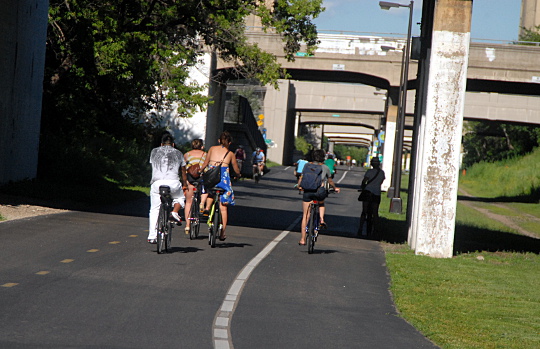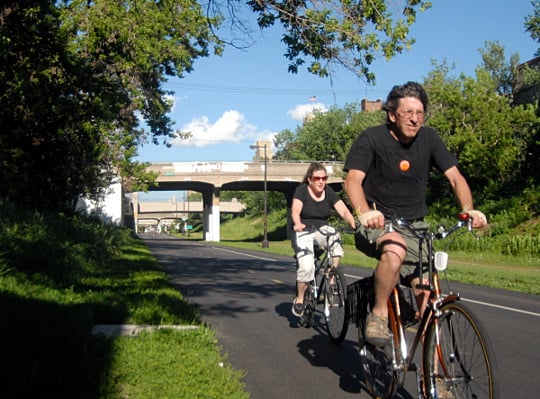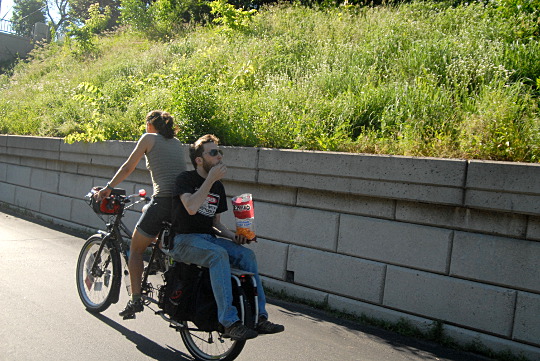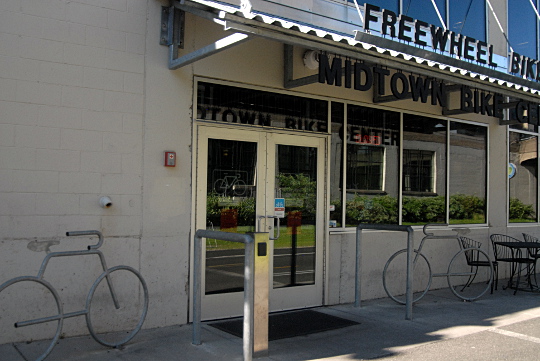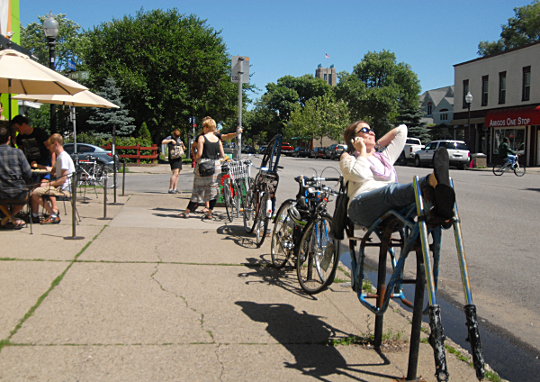
(Photos: M.Andersen/BikePortland)
Now, don’t get me wrong: Minneapolis is a great place to ride a bicycle.
It has lots of things that Portland can and should learn from. And yes, those things they do in the November snow and the August sweat are seriously impressive. But is Minneapolis a better biking city than Portland?
Don’t be silly. It is not.
This post is not a rag on Minneapolis, one of the most successful cities in the country and a place I’d be happy to spend $59.95 (or whatever houses there are going for these days) to move to if it ever came to that. Nor am I trying to rank two totally different places, a fun game that’s usually also silly.
Instead, this is a quick, honest look (based on a three-day visit last week) at the things that do and don’t work about pedaling around one of the few American cities whose residents’ love of biking seems to match up with ours.
Let’s start with the biggest problem with most Portland/Minneapolis biking comparisons.
The main reason Minneapolis has a fairly high bike-commuting rate (4.5%) is that its city limits are quite small.
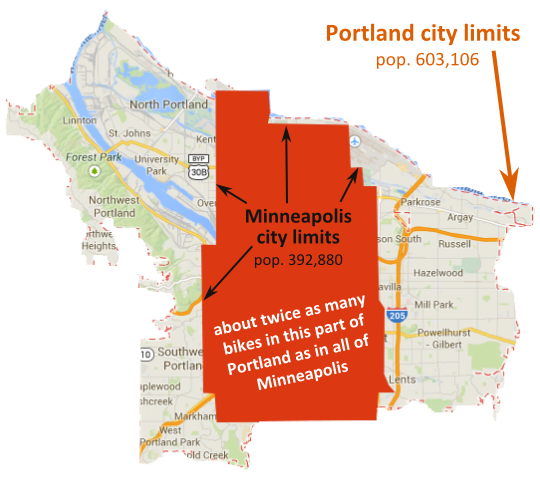
The Twin Cities metro area has about 50 percent more residents than the Portland metro area — it’s about the population of greater Seattle. But at 55 square miles, its central city, Minneapolis, happens to be one of the smallest major cities in the country. (Another often-cited city, Washington DC, is 61 square miles; Seattle is 84, Portland is 133, Chicago and Tucson are both 227 and New York is 305.)
This isn’t a bad thing, and it probably helps elect pro-bike politicians. (When incoming Mayor Betsy Hodges used her first proclamation in office to call Portlanders “wimpy,” I wondered if Charlie Hales was going to take it lying down. He did.) But it’s a perfect example of why Census-based city rankings are mostly matters of municipal coincidence. If Portland’s city limits suddenly shrunk to the size of Minneapolis, our bike commute rate would leap to a whopping 9 percent.
If you want a slightly better apples-to-apples comparison, compare the entire Portland metro area’s bike commuting rate (2.2 percent) to the Twin Cities metro area’s (1 percent).
That said, bikes are a huge part of Minneapolis culture. So why do its statistics lag Portland’s? Here’s part of the issue…
There are freeways freakin’ everywhere.
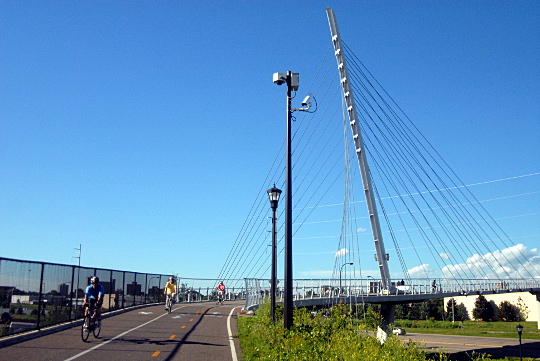
Above is the majestic seven-year-old cable-stayed bike-ped bridge that connects the Midtown Greenway to the new Hiawatha path into downtown. It’s a beautiful piece of federally funded engineering that deserves its iconic status in the city.
And here’s why it had to be built:
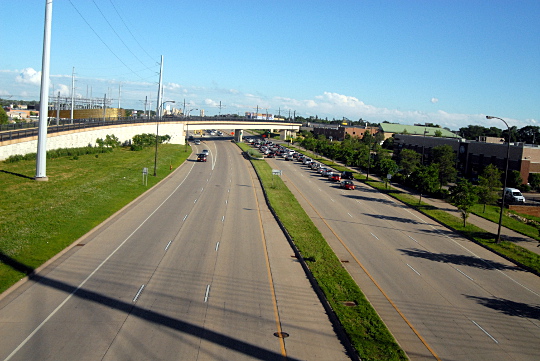
That’s Hiawatha Avenue, a six-lane stroad that chops through Minneapolis between downtown and Minnehaha Park. Fifteen years ago, a Hiawatha Avenue expansion project gave rise to the Minnehaha Free State, a beautiful but unsuccessful anti-highway protest; today this is just one of the ridiculous number of expressways that slice the city’s street grid to bits. Minneapolis has spent a lot of money repairing itself with bridges like the one above. But there’s only so much you can do.
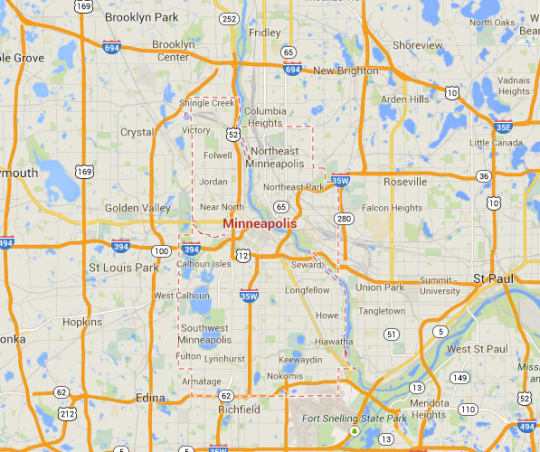
Portlanders congratulate ourselves more than we deserve for having killed the proposed Mount Hood Freeway through Southeast Portland in the early 1970s. At the time, more or less the same thing was happening in almost every major U.S. city, including Minneapolis.
But here’s a fact: today, the Twin Cities metro area has 50 percent more lane-miles of freeway per capita than Portland’s and 39 percent more lane-miles of arterial street. Well after the cheapskates and elitists of Portland started saying “no” to roadway widenings, Minneapolis’s idealistic Lutherans kept on saying “sure!” They created a region that remains deeply auto-dependent.
The Midtown Greenway is amazing, but a path is not a substitute for a street.
Minneapolis should be proud of the Midtown Greenway. The entire country should be proud of the Midtown Greenway.
It’s the most impressive urban rail-to-trail project I’ve seen, connecting commercial, industrial and residential neighborhoods in a straight shot through a sunken, forested railroad bed across the near south side of the city. Its effect on bicycle commuting patterns is practically visible from space.
This is what people look like when they are riding on the Greenway:
But here is the fundamental problem with the Midtown Greenway: the only storefront that seems to face it is a bike shop. In this case, a closed bike shop.
Off-street paths are wonderful parts of a bike network, and this one blows our Springwater Corridor away on width, location and connectivity. But if I were choosing a commute, I’d take the neighborhood greenways on Ankeny, Holman or Michigan over the Midtown any day. When I ride, I want to enjoy the full culture of my city: houses, cafes, cats. The Midtown Greenway’s links to neighborhoods are numerous and well-marked. But during my third trip on the path, cruising blindly through a city I was supposed to be exploring, I realized what all the curving exit ramps reminded me of.
I was on a tiny freeway.
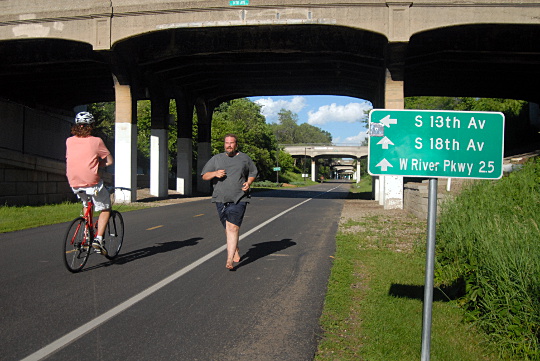
Another limitation of paths: safety. One rule of thumb for avoiding urban crime is to always be in eyeshot and/or earshot of at least two strangers. Most city streets would pass that test at 10 p.m. on a Saturday night in June. The Greenway didn’t.
I’ll say it again: this off-road path is terrific and I’d be in heaven if Portland had something like it. But off-road paths can’t do everything.
Advertisement
The bike lanes are pretty good. Sometimes.
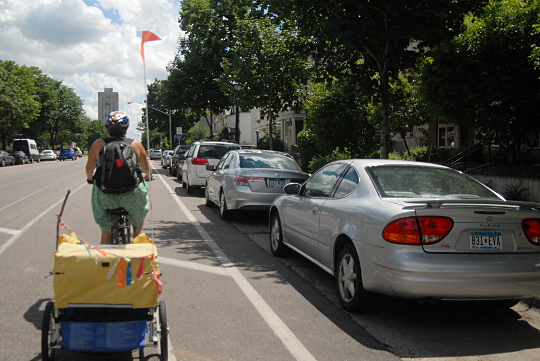
The best bike lanes in Minneapolis are as good or better than the best in Portland. The above shot is from Portland Avenue South, the auspiciously named local equivalent of North Williams Avenue. I love the double-barreled buffers, clearly separating bikes from both parked and moving cars.
Unfortunately, here’s the same important bicycle route a few blocks north.
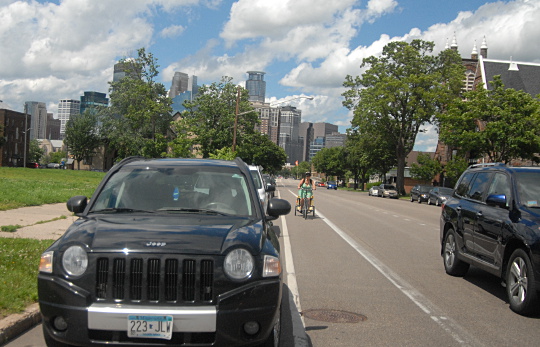
Here’s a nice use of a contraflow bike lane for a one-block connection…
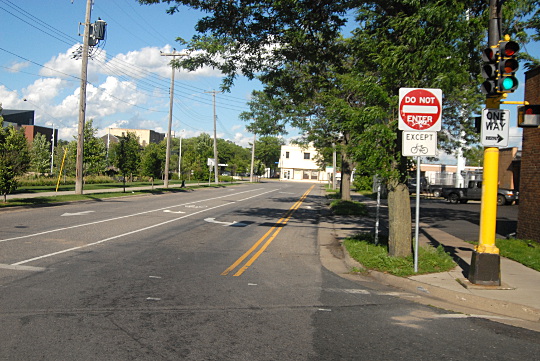
…and here’s a street that generously invites bicycles into the gutter.
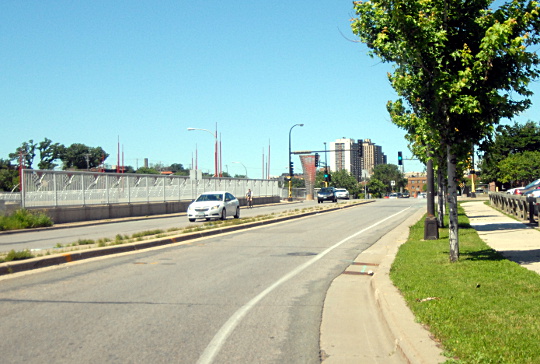
Here’s a major downtown street that, like many of them here, offers a conventional bike lane…
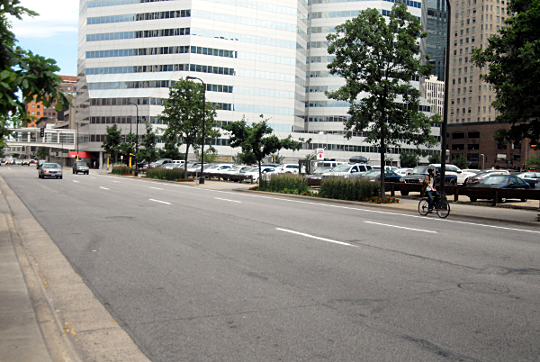
…and here’s a vast speed-bait expanse on the northwest side of downtown that didn’t exactly seem to be living up to the potential of the most valuable real estate in the Upper Midwest.
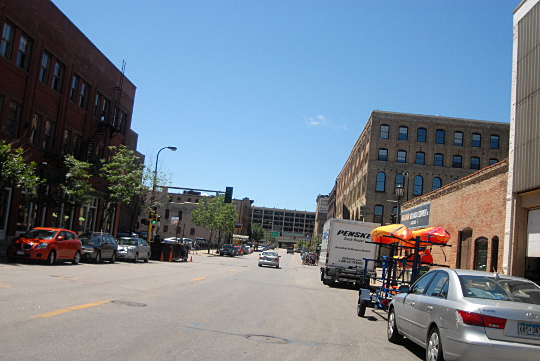
Unfortunately, one reason Minneapolis has been able to carve out a lot of room for nice bike lanes is also probably its biggest obstacle to further bike-friendliness. Compared to Portland, its roads are big and its auto lanes are wide. All that pavement invites speeding, slows walking and, despite many wonderful exceptions, deadens street life.
The waterfront paths are, OK, fantastic.
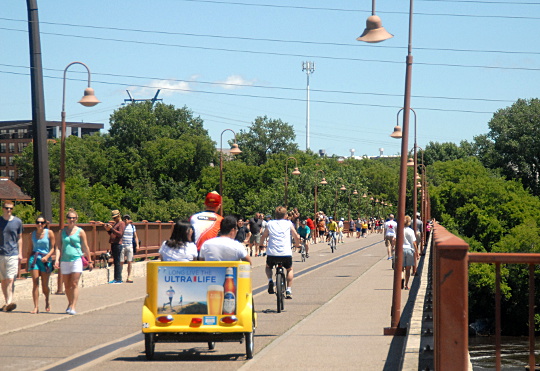
We didn’t get a chance to ride over many of the city’s bridges, though I’m told they’re impressive. But here’s a look at one: the wonderful Stone Arch Bridge, built as a railroad crossing but now a car-free link between the waterfront parks on each side of the Mississippi. Also, I wondered whether or not the folks at Portland Pedicabs have ever put in for a Michelob Ultra contract.
The bike parking could use some work.
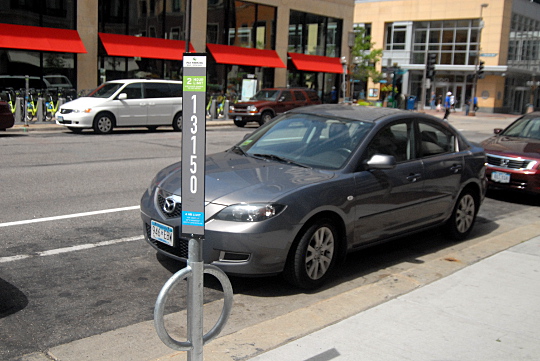
If any city on the continent can match Portland’s bike parking, I haven’t seen it yet. One nice touch in Minneapolis is that some of the auto parking signs double as bike parking. But on a busy Sunday downtown, those weren’t enough to stave off the great American tradition of locking one’s bicycle to any pillar available.
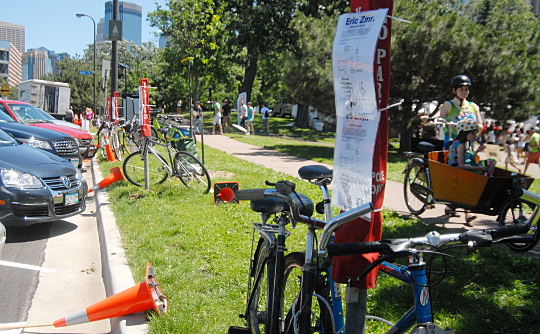
A good bike city, not yet a great one
There are lots of details I haven’t mentioned. For example, one of the country’s best bike-share systems, which plenty of locals were using and seemed to have a station everywhere we wanted to stop. Or the out-of-town bike connections, which I know nothing about but which it’s hard to imagine can compare to the Columbia Gorge or Pacific coast. Or the fact that in a more ethnically diverse city than Portland, the people using bikes seemed much more diverse, too.
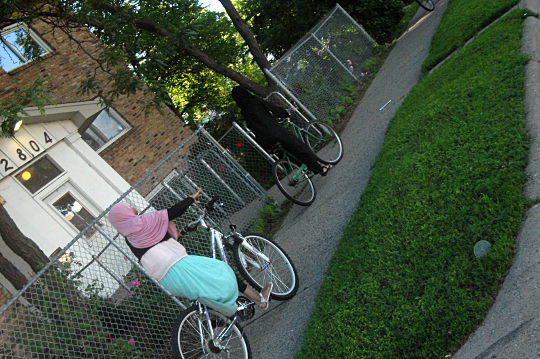
Four years ago, Bicycling Magazine did both Portland and Minneapolis a big favor when it flipped Minneapolis to the top of its “best bicycling cities” rankings, before reversing the order again in 2012. (I think every single Minneapolitan who learned we were from Portland, bicycle user or otherwise, brought up that ranking.) The magazine’s next two-year update of that list is suspiciously overdue, but I hope it’s on the way, because it’ll give everybody something new to talk about.
And I hope that, once again, it’ll use dubious logic to claim that some new American city has become the best place to ride a bicycle. There isn’t a city in the world that knows all the secrets. Let’s all look forward to our next excuse to learn somebody else’s.
